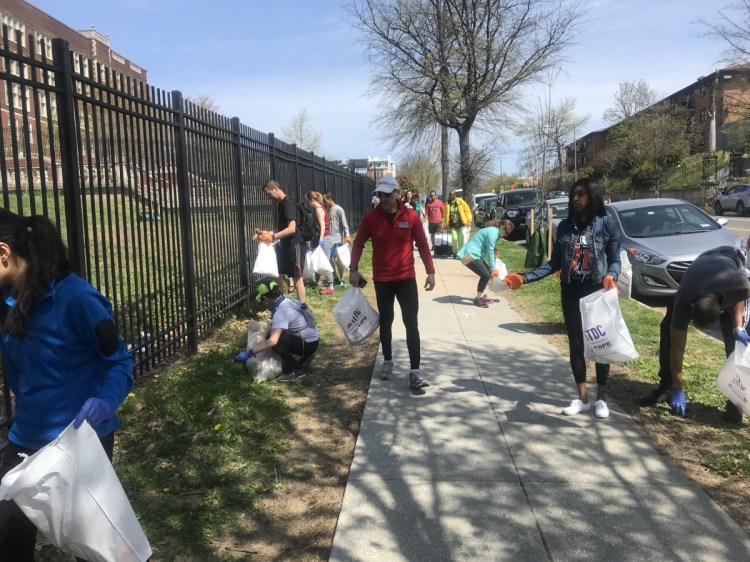The fitness trend – earth-friendly implications and all – has been catching on in the United States.
Bernard Kelly headed out for a Sunday-morning run late last month the same way he often does – with two plastic grocery bags in his hands. By the time he returned from his 11-mile trip, the 45-year-old Greenbelt, Maryland, resident had built up a healthy sweat, and not just from running under the warm spring sun, but from carrying back the two bags full of trash he had collected along his route.
This has been Kelly’s weekly routine for the past year and a half, and it wasn’t until recently that he learned that his environmentally conscious training method has a name – plogging – or that it has been dubbed one of the fitness trends of the year.
“I hate litter,” said Kelly, a regular marathon runner. “I just call these junk miles, miles you fill up after your hard runs.”
The Swedes are credited with popularizing the multitasking practice. Plogging is a combination of jogging and “plocka upp,” the Swedish term for pickup. The fitness trend has begun to spread in the United States, with plogging Facebook groups and social events sprouting up across the country.
On Earth Day this year, the D.C. Department of Parks and Recreation hosted a plogging event in Northwest Washington, so I headed over to the Raymond Recreation Center and Playground to try it for myself. As an occasional marathon runner, I was curious about whether I’d get any physical benefit from it, as well as how much trash I’d be able to find.
The temperature was a warm 63 degrees with a slight morning breeze – perfect plogging conditions. A few dozen people were already waiting when I arrived. “I’ll be your plogger in chief today,” running coach Jeff Horowitz told us. “When we see trash, we’ll be like well-meaning locusts.”
Horowitz guided us through warmup exercises and the proper way to pick up trash, which is to squat down instead of bending over. (“You can injure your back if you don’t,” Horowitz said.) Afterward, with latex gloves on and plastic bags in our hands, we headed off for the 21/2-mile jog.
It didn’t take long to spot trash. Turns out when you’re intently looking for trash to pick up, you begin to realize how much there is. Cigarette butts lined the sidewalks, and it was stop-and-go before we made it out of the first block. Horowitz reminded ploggers to announce when they were picking up trash to avoid crashing into one another.
The amount of waste we collected surprised Nick Hake and Rumiko Ito of Alexandria, Virginia, who had heard about the event in a radio ad. “I expected some, but didn’t expect all the small pieces,” Hake said.
Hake, 37, said he and his wife run frequently but were first-time ploggers. To Ito, 38, the event, which was hosted in partnership with the Washington-based gym Vida Fitness, sounded like a “good mix of exercise and helping clean the community.”
Marcus Markle, a program analyst with the D.C. Department of Parks and Recreation, said plogging dovetails perfectly with FitDC, an initiative by D.C. Mayor Muriel E. Bower to link community members with nutrition and fitness resources, and his department’s efforts to make Washington the fittest city again. The American College of Sports Medicine and the Anthem Foundation named Minneapolis the fittest city in its annual American Fitness Index last year after Washington was No. 1 the previous three years.
“Plogging helps people take ownership of their own community,” Markle said. “I think it has that sense of community, and people can come out and feel like they’re helping make their community a better (place).”
It can also help runners work on muscles they typically don’t focus on, and the slower pace can serve as the “perfect recovery day,” Horowitz said. “We were squatting, bending and activating the glutes,” added Horowitz, a 53-year-old personal trainer for Vida Fitness who said he has completed more than 190 marathons. “It’s movement outside of the regular plane of running. The risk of injury in running is that you’re maintaining weaknesses in the muscles you don’t use directly.”
By the time we reached the midway point, I had emptied my bag of trash twice. I picked up pizza boxes, plastic bottles, bandages, candy wrappers and what appeared to be a stack of counterfeit Washington Capitals playoff tickets. (No, I did not keep them.)
Even though we were going at a leisurely pace, with plenty of waiting, I still got in thousands of steps and worked up a light sweat. And I felt as if I was making a difference.
On the way back to my car, I kept spying trash on the ground that I wouldn’t have noticed before the run. As I wiped sweat from my forehead, I bumped into another plogger, Jennifer McGough, a 34-year-old elementary school teacher who had also attended the event. While she didn’t find plogging physically challenging, she said it gave her a new perspective.
“It really does bring attention to all the litter around,” she said. “I would definitely do it again.”
Copy the Story LinkSend questions/comments to the editors.



Success. Please wait for the page to reload. If the page does not reload within 5 seconds, please refresh the page.
Enter your email and password to access comments.
Hi, to comment on stories you must . This profile is in addition to your subscription and website login.
Already have a commenting profile? .
Invalid username/password.
Please check your email to confirm and complete your registration.
Only subscribers are eligible to post comments. Please subscribe or login first for digital access. Here’s why.
Use the form below to reset your password. When you've submitted your account email, we will send an email with a reset code.